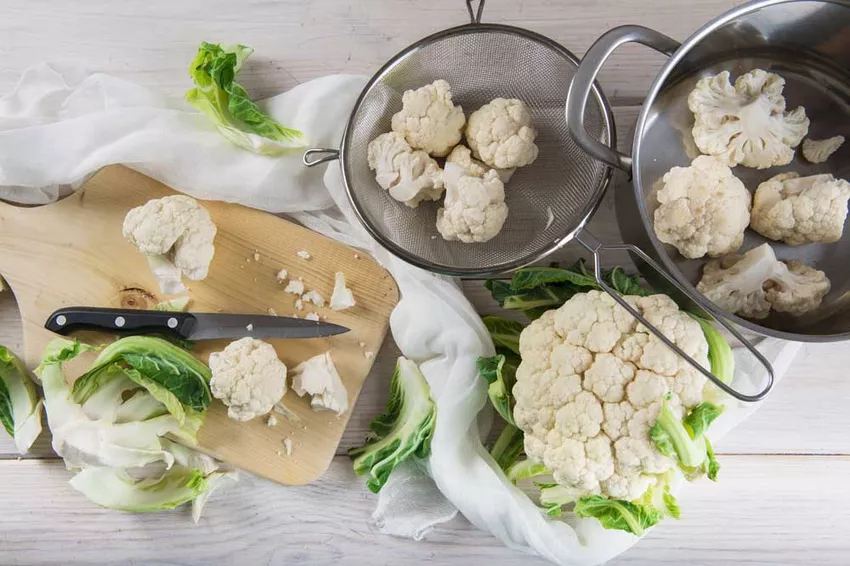Freezing cauliflower is not a great art. Nevertheless, there are a few things to consider, for example to avoid freezer burn.

Sometimes the cauliflower harvest is bigger than expected. Then good advice is expensive as to what to do with the remaining florets. One option is to simply freeze the cauliflower. However, you should follow a few principles to ensure that the nutrients and taste are preserved.
Can the whole cauliflower head be frozen?
No, unfortunately not. You have to do some preparatory work in advance so that there is no rude awakening when defrosting later. Cauliflower as a vegetable tastes best when it is crunchy and al dente.
How to Freeze Cauliflower

1. Preparations for freezing cauliflower:
First you should remove the stalk from the cauliflower and divide it into florets. Then it's time for washing. Either hold the individual pieces under a running stream of water or prepare a water bath. During the cleaning, make absolutely sure that all parts of the soil and other dirt are removed. Even small insects can get lost in the rosettes.
Once the florets have been cleaned, they are well prepared for freezing. However, professionals advise blanching the cauliflower beforehand. If you don't have time, you should let the individual cauliflower florets dry well at this point.
2. Blanch cauliflower:Tip:
The stalk is bitter and is only needed to boil asparagus soup and the like. This also applies to the green leaves. So do not throw away these parts, but process them further.
Blanching means that the cauliflower is placed in boiling water for a short time. The duration should not exceed 2 to 3 minutes. After this time, you then place the individual florets in very cold water to deter them. A bowl of cold water and a few ice cubes works best for this.
Blanching seals the cell structure, so vitamins and nutrients remain in the cauliflower. This is even more important when the vegetables afterwardsshould be frozen. The side effect is that the cauliflower has a much longer shelf life and doesn't decompose as quickly. This also applies to the time in the freezer. A blanched cauliflower is therefore fresh and durable for much longer.
Tip:
Blanching is also recommended for other types of vegetables. For example, if you want to freeze carrots, dry potatoes or pickle ginger in a sweet and sour way.
3. Thoroughly dry rosettes:
It is important that only absolutely dry vegetables go into the freezer. Otherwise the moisture would freeze on the cauliflower florets and form ice crystals on the vegetables or the wall of the bag. The problem: The so-called freezer burn can be dangerous because it destroys the vegetables in these places. Externally it is not necessarily visible. You will only see the result after defrosting.
Regardless of whether you have blanched the cauliflower florets or not: the vegetable pieces must be dried very well before they can be frozen. This works best if you let the cauliflower drain on an absorbent cloth. By the way, you don't need help. After about 15 minutes at room temperature, the moisture has usually evaporated.
What can cauliflower be frozen in?

You can use a commercial freezer bag or a freezer box for freezing. However, both variants must be easy to close. Therefore, make sure that the lid of a freezer box fits well. Plastic containers for the freezer are therefore often specially marked. This also means that the plastic must be food grade.
Tip:
Freezer bags are usually closed with a wire or snap fastener. You should remove as much air as possible. This works by squeezing out as much air as possible with your hands after you have filled in the cauliflower. If you have a vacuum sealer, you can also force the air out of the bag electrically.
How long does frozen cauliflower last?
Normally, the temperature in a chest freezer or freezer is around -18°C. This ensures that food is no longer subject to natural processes and has a long shelf life. Although you can preserve vegetables this way, frozen foods do not keep indefinitely. For vegetables like cauliflower, the average shelf life is around a year. After that he shouldCauliflower must be processed.
How to process the cauliflower after freezing?
If the cauliflower is to be prepared as a cooked vegetable after freezing, it does not need to be thawed. You can simply add the frozen florets to the boiling water and prepare as usual. Cooking time remains the same as fresh cauliflower.
However, if you want to use the cauliflower for a stir-fry or in a casserole, for example, you should thaw the frozen cauliflower gently in the refrigerator beforehand. Alternatively, gentle defrosting in the microwave is also possible.